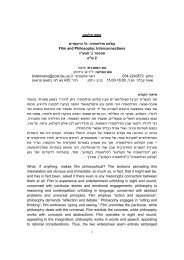The Iconography of the Temple in Northern Renaissance Art
The Iconography of the Temple in Northern Renaissance Art
The Iconography of the Temple in Northern Renaissance Art
You also want an ePaper? Increase the reach of your titles
YUMPU automatically turns print PDFs into web optimized ePapers that Google loves.
Accord<strong>in</strong>g to <strong>the</strong> moralization <strong>the</strong>y were to rema<strong>in</strong> outside <strong>the</strong> <strong>Temple</strong> because<br />
<strong>the</strong>y were ignorant <strong>of</strong> <strong>the</strong> True Faith.<br />
<strong>The</strong> <strong>Temple</strong> <strong>in</strong> <strong>the</strong> form <strong>of</strong> <strong>the</strong> Dome <strong>of</strong> <strong>the</strong> Rock<br />
Although <strong>the</strong> two edifices on Mount Moriah were known to <strong>the</strong> West before<br />
<strong>the</strong> Crusades, <strong>the</strong>y are mentioned <strong>in</strong> pilgrims' writ<strong>in</strong>gs only after <strong>the</strong> Crusader<br />
Conquest <strong>of</strong> Jerusalem (1091). At that time <strong>the</strong> Dome <strong>of</strong> <strong>the</strong> Rock was identified<br />
as Templum Dom<strong>in</strong>i, while <strong>the</strong> El Aqsa Mosque was called ei<strong>the</strong>r Templum<br />
Solomonis, or Solomon's Palace.<br />
With <strong>the</strong> conquest <strong>of</strong> Jerusalem, <strong>the</strong> Dome <strong>of</strong> <strong>the</strong> Rock was identified as <strong>the</strong><br />
'House <strong>of</strong> God' (Be<strong>the</strong>l). 54 It was converted <strong>in</strong>to a church and became <strong>the</strong> symbol<br />
for <strong>the</strong> Holy Church.<br />
On 12th century pilgrims' maps Templum Dom<strong>in</strong>i (<strong>The</strong> Dome <strong>of</strong> <strong>the</strong> Rock) is<br />
shown as a circular structure while Templum Solomonis figures as a basilica.<br />
Sometimes both monuments appear <strong>in</strong> basilica shape, always topped with a<br />
cross. 55<br />
<strong>The</strong> conceptual representation <strong>of</strong> <strong>the</strong> <strong>Temple</strong> that characterises 12th century<br />
cartography was later replaced by a more documentary approach. On 15th<br />
and 16th century maps <strong>the</strong> Dome <strong>of</strong> <strong>the</strong> Rock no longer figures as Templum<br />
Dom<strong>in</strong>i. It is called Templum Solomonis and is adorned with a crescent topp<strong>in</strong>g<br />
a dome or <strong>in</strong>corporated <strong>in</strong> <strong>the</strong> dome itself as a sign <strong>of</strong> heresy. 55a<br />
Toward <strong>the</strong> middle <strong>of</strong> <strong>the</strong> 15th century, we f<strong>in</strong>d "realistic" or 'documentary'<br />
depictions <strong>of</strong> Jerusalem, ma<strong>in</strong>ly <strong>in</strong> two centres: (1) <strong>the</strong> Burgundian court, where<br />
<strong>the</strong> "realistic" attitude is related to <strong>the</strong> dream <strong>of</strong> a New Crusade cherished by<br />
Duke Philippe le Bon, who wished to purify <strong>the</strong> Holy City <strong>of</strong> heretics; and (2)<br />
<strong>the</strong> Court <strong>of</strong> K<strong>in</strong>g René le Bon, Duke <strong>of</strong> Anjou, K<strong>in</strong>g <strong>of</strong> Sicily, who was also<br />
titled “K<strong>in</strong>g <strong>of</strong> Jerusalem”. 55b<br />
In <strong>the</strong> Three Maries at <strong>the</strong> Tomb by Van Eyck (Rotterdam, Museum Boymans<br />
Van Beun<strong>in</strong>gen, before 1426; fig. 3), a recognizable Dome <strong>of</strong> <strong>the</strong> Rock dom<strong>in</strong>ates<br />
<strong>the</strong> view <strong>of</strong> Jerusalem, 56 which some scholars have considered to be based on<br />
direct experience. 57 Although <strong>the</strong> outl<strong>in</strong>e <strong>of</strong> <strong>the</strong> shr<strong>in</strong>e is identifiable, <strong>the</strong> city<br />
view itself is a miscellany <strong>of</strong> Lombard, Gothic and oriental elements. 58<br />
<strong>The</strong> so-called "realistic" views <strong>of</strong> Jerusalem <strong>in</strong> <strong>the</strong> background <strong>of</strong> scenes<br />
related to Christ's Passion or Death are, <strong>of</strong> course, not <strong>in</strong>tended to serve as<br />
au<strong>the</strong>ntic portraits <strong>of</strong> <strong>the</strong> Holy City. Ra<strong>the</strong>r, <strong>the</strong>se views, especially when <strong>the</strong>y<br />
are dom<strong>in</strong>ated by <strong>the</strong> <strong>Temple</strong>, have a symbolical mean<strong>in</strong>g. In this particular<br />
context, <strong>the</strong> Dome <strong>of</strong> <strong>the</strong> Rock outl<strong>in</strong>e for <strong>the</strong> <strong>Temple</strong> would represent Synagoga,<br />
as related to <strong>the</strong> Jews' betrayal <strong>of</strong> God. 59<br />
<strong>The</strong> <strong>Temple</strong> <strong>in</strong> <strong>the</strong> background <strong>of</strong> Christ's Passion sometimes confers ano<strong>the</strong>r<br />
158
















